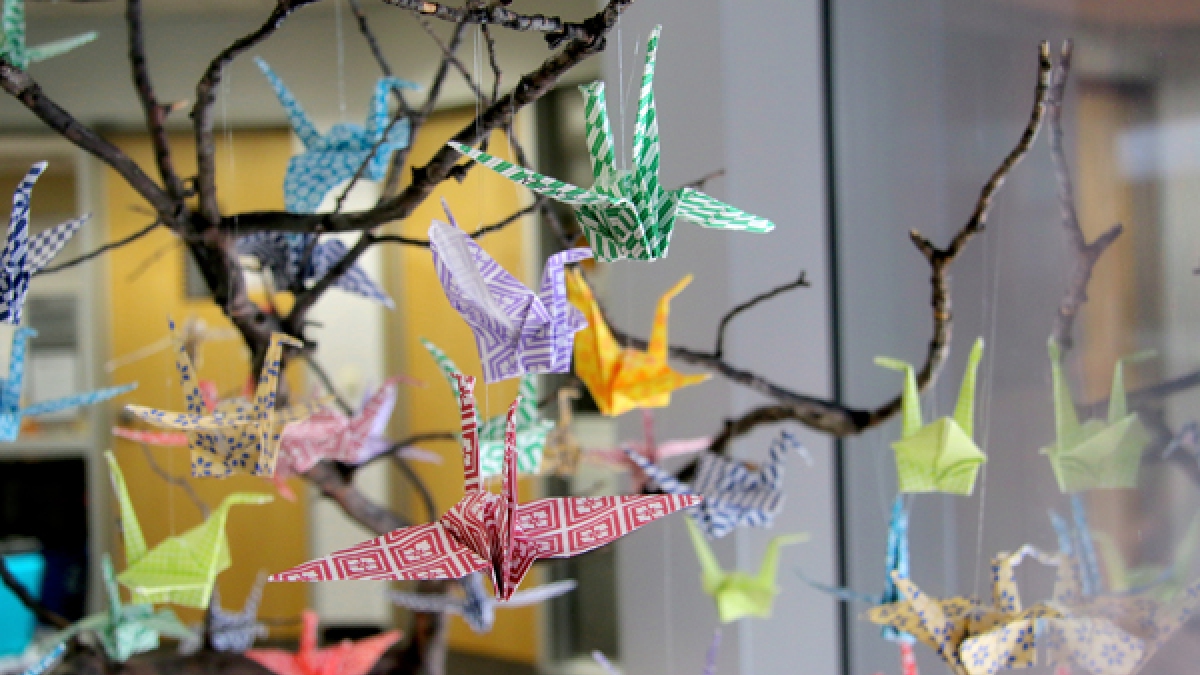Public art explores portraiture with community artists

A portrait can take many forms. It can express thoughts, relationships, memory and even community.
The public art exhibition “Portrait of a Community” showcases the work of more than 75 community visual artists in the University Center on Arizona State University’s Downtown Phoenix campus. The exhibit includes community art from working professionals alongside emerging young artists.
Organized by the College of Public Programs’ Action, Advocacy, Arts series, the public art exhibit provides community organizations and individuals the opportunity to share valuable visual art stories with more than 8,000 people in the downtown ASU community.
The exhibit will run through May 9, and is displayed on the first, second and third floors of ASU’s University Center at 411 N. Central Ave. The vibrant and dynamic exhibition features more than 115 works of art submitted in response to a community-wide call to artists. Submitted works stretch along the busy and bustling hallways filled with students, faculty, staff and visitors.
“We have drawings of cities, parks, imaginary landscapes, what you hoped your community would be, and really traditional portraits,” says Carrie Tovar, curator of art for the College of Public Programs. “These are the people who live in our community. It’s a great juxtaposition.”
Community-building
The exhibit explores portraiture on an individual and community-wide level. Artists of all ages submitted 2-D and 3-D visual representations of the buildings, homes, landscapes and people in their community. Canvases filled with abstract clay shapes jut out from hallway walls amid hand-drawn maps and hanging collages.
“Portraits can be of all different kinds of things. It can be a portrait of a human, or a likeness of an individual, but when you think of portrait of a community, it’s also a portrait of the place you live,” Tovar says.
The “Action, Advocacy, Arts” program uses the arts as a central vehicle to build relationships among the community and ASU students, faculty and staff.
“The art here is visible to staff, faculty and students in the ASU community, but the exhibits also help us find our place within the greater downtown neighborhood by asking community artists to participate,” Tovar says, adding that the “Action, Advocacy, Arts” program has allowed the College of Public Programs to form relationships with the greater Phoenix community, including individual artists, schools and nonprofit organizations.
Community-inspired
Artist Tasili Epperson’s portraits, “Grandpa Jim” and “Momma Yakka” capture the overlooked beauties of everyday life. Her oil painting reflects shadows on a face, freckles dancing on a shoulder, wrinkles and furrowed brows.
Epperson, who graduated from ASU with a bachelor's degree in painting and drawing, chose to participate in the exhibit because community plays a large role in her work.
“I wanted to share my perspective on the importance of relationships with others. I am deeply fascinated by humans and relationships, and this exhibit honors the sacred nature of humans in a community,” Epperson says.
Artist Caiti Benefiel has several art works in the exhibit: “Essence of Music,” “Wild Heart,” “Flawless Imperfections,” “Dana Point, CA” and “Self Portrait.”
“When I saw the theme of the exhibit, I had immediate inspiration to create pieces that helped people see these things in a different way,” Benefiel says. “The Community Arts Program has given me the opportunity to have my art seen by a wide range of people. It has also given me the opportunity to discover other local artists and see what the community is doing as a whole.”
Charisse Warsco chose to display her Dia de los Muertos mask line made with the community in mind.
“These designs were inspired by the community, molding their meanings to whatever member stands in front of them,” Warsco says. “When I design a mask, I am more interested in creating an experience, and I let each mask become a vessel to these new places.”
Art teacher Farhana Shifa Ahmed has two works in the exhibit – “Desert Beauty” and “Women of Many Religions” – along with others from her students.
Ahmed said the opportunity to display her work along with her students helped her be proactive in her teaching of diversity, celebrating communities and viewing the world with a new perspective.
“ASU's all-inclusive art program helps budding artists to come forward, emerging artists to teach new messages … children to gain confidence to express themselves,” Ahmed says. “I believe this is a wonderful initiative of ASU that will slowly but surely make changes in people's lives.”
The gallery is free to view and open to the public from 8 a.m. to 5 p.m., daily, except for holidays. Guided tours may be arranged by contacting Carrie Tovar at carrie.tovar@asu.edu. For more on Action, Advocacy, Arts, visit copp.asu.edu/about/action-advocacy-arts.
Written by Adrianna Ovnicek